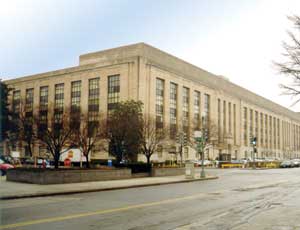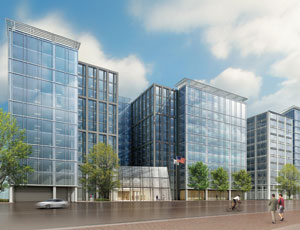Focus on D.C. Firms flock to public projects while private jobs remain stalled
Two years ago, the D.C. construction community was overwhelmed with opportunities and hard-pressed to find enough hands to take on work.


These days, many firms are burning backlog and hoping they can hold on until the economy rebounds and private projects begin to flow again.
Despite the steady stream of government work that has historically made D.C. relatively recession-proof, the severely frozen private market brought on by the national credit crunch has sent a flood of firms scrambling into the limited pool of public work. It’s a scenario that has made for fierce competition and low-ball bidding.
“The competition level for work here is unlike anything I’ve ever seen,” says John Tarpey, division president and chief executive officer of Balfour Beatty Construction in Fairfax, Va. “It’s not unusual to see more than 40 bidders on a job that would have had less than 10 bidders in the past. On almost every single [bid result], we see someone who is significantly lower than the rest of the field.
“It’s not uncommon to see bids coming in at more than 30% below budget. That’s a sign of desperation.”
While general contractors and architects may be trimming margins to find work, the subcontracting community is a prime contributor to pricing pressure, says John Barron, president of Foulger-Pratt Contracting in Rockville, Md. He says that subs without the luxury of months of backlog are quoting unreasonably low prices just to keep afloat.
“The problem for GCs is that they may be relying on subs who are in a delicate state and taking chances,” he says. “If you go with those subs and you’ve already got low margins, you’re now the one in a fragile state. If those subs start going belly-up, there will be a ripple effect that could take a few GCs with them.”
Going Public Like many firms in the area, Foulger-Pratt has followed the market and shifted its focus from private work to public jobs. The firm landed one of the few large private projects in the metro area to secure financing this spring—the $80-million, mixed-use Penrose Square in Arlington, Va. The project, which was designed by Heffner Architects of Alexandria, Va., is scheduled for completion in late 2011.
Still, Barron recognizes that jobs like Penrose are a rare find these days.
“With the banking side of the equation being so challenging for private developers, it’s become the federal show,” he says. “If you haven’t moved into the federal market, where will you get your work?”
Harkins Builders of Marriottsville, Md., is following a similar path. In recent years, the company has made a strong push into the District with several mixed-use and multifamily residential projects. Harkins is currently building private projects at 2300 Pennsylvania Ave. and Parkside Terrace in D.C.
However, Larry Kramer, Harkins’ vice president of preconstruction, sees few opportunities in the near-term within the District and says he expects many of Harkins’ larger pursuits to be federal projects in the surrounding region. In May, the company was awarded a $69-million design-build contract for a 129-unit student headquarters at Marine Corps Base Quantico, Va.


Kramer says that when the credit market improves, Harkins expects be in the mix in the D.C. market again.
“There’s a lot of stuff in the pipeline that is just waiting for financing,” he says. “We’re hoping that between mid-2010 and 2011, we could see a swell of [private] development that will take some people by surprise.”
WDG Architecture of Washington is also keeping its short-term focus on public jobs with hopes for a private market rebound on the horizon. The company has traditionally landed 90% of its work in the commercial and multifamily sectors.
However, it has seen some of its closest clients struggle recently, including D.C.-based Opus East, which filed for Chapter 7 bankruptcy in June. WDG designed Opus East’s $180-million, 1015 Half Street, SE, project, which broke ground last year.
This year, the firm finds itself seeking design-build jobs for public clients, including upcoming federal stimulus package projects, says Eric Liebmann, managing principal and director of design at WDG. The firm is part of the design-build team led by Clark Construction of Bethesda, Md., selected in February to deliver the $80-million Oakland Hall Dormitory at the University of Maryland’s College Park campus outside D.C.
Meanwhile, Liebmann says WDG is also keeping a hand in the private market. “We’re seeing a lot of people push things through the entitlement process,” he says. “Some people have an optimistic view and are getting things ready to go, but they are trying to keep their investments minimal for now.”
Big Shift The area’s largest contractor, Clark Construction, isn’t immune from the changing market. The company broke ground on four of the five largest projects in the District last year, including the $600-million Constitution Square and the $101-million Arena Stage projects, which are being developed by private owners.
This year, the company has seen all of its local wins in the public sector, including the $51-million, 140,700-sq-ft Rockville Science Center for Montgomery College and the BRAC 133 project at Mark Center in Alexandria for the U.S. Department of Defense.
Clark and many of its competitors have also been eyeing some of the larger projects set to let through funding from the American Recovery and Reinvestment Act. The U.S. General Services Administration has more than $1 billion in stimulus funding earmarked for local projects, including $450 million for the new U.S. Department of Homeland Security headquarters planned at the St. Elizabeth’s Hospital campus in D.C.
Several federal buildings in D.C. will also undergo modernization to make them more energy efficient, including $225.6 million for phases two and three of the Dept. of Commerce Herbert Hoover Building; $161.3 million for the GSA Headquarters; and $128.8 million for the Lafayette Building.
With a strong emphasis on modernization work and green upgrades, the stimulus package has played to the strengths of contractors such as Grunley Construction of Rockville, Md. This summer, the company was awarded a $35-million contract to complete renovations to the Mary E. Switzer Building in D.C. The job is funded through the ARRA.


Grunley completed phase one of the building in 2008, but funding wasn’t available to award the second phase until it was added to the stimulus package, says Ken Grunley, president of Grunley Construction. Likewise, other projects that the firm has been tracking, including plans for the Hoover and Lafayette buildings, were stalled until the stimulus put them in motion.
“We had options on some of this work, but never could book those dollars,” he says. “We’ve got a good backlog now and a few more [bid] awards should get us through the bad times.”
Stagnant Stimulus Although the stimulus promises to inject opportunities into the Washington market, projects have been slow to move. By the end of June, federal agencies had awarded few projects locally, but prospects have since improved.
“I was a lot more concerned around April or May about what would happen,” says Bill Stinger, senior principal at HOK in Washington. “In June, we started to see a pickup in solicitations from a whole variety of federal agencies. We’re cautiously optimistic that these will be real projects by September.”
Despite the down economy, some unexpected sectors, such as federally funded cultural projects, continue to move forward. Russell Perry, managing director of SmithGroup in Washington, says the architecture firm has seen growth in its cultural studio this year. Stimulus dollars helped restart its stalled work at the Smithsonian Institution’s Arts and Industries Building. The company is also working on a master plan for the Smithsonian Institution Building, known as “The Castle.”
SmithGroup partnered with Freelon Adjaye Bond to design the National Museum of African American History and Culture. It will take up to three years to design the $500-million project with construction to begin in 2012. The museum is scheduled to open in 2015.
Between new cultural projects and some awards in institutional sectors, such as health care and higher education, Perry says the business is beginning to pick up.
“It’s not uncommon to see bids coming in at more than 30% below budget. That’s a sign of desperation.”
“The first quarter [of 2009] turned out not to be as bad as we thought, the second quarter was strong and our third quarter will be the strongest we’ve seen in a year,” he says. “We’re not out of the woods yet. We don’t have a lot of projects in construction documents right now, so I don’t know what the future holds.”
With the bulk of stimulus projects on short timelines and the latest round of BRAC work winding down by 2011, many firm executives admit they aren’t sure when the next wave of work will come.
Reg Arnold, senior regional vice president of Structure Tone in Washington, says he is banking on an echo of work to follow BRAC. “The government moves, then the [federal] contractors follow, and a lot of them have special needs like security work,” he says.
“We’ve even seen people talking about hospitality again. Around these new BRAC facilities, people will need temporary lodging, and we’re hearing private developers talk about hotels in those areas. More work will come. It’s just a matter of riding out the storm.”